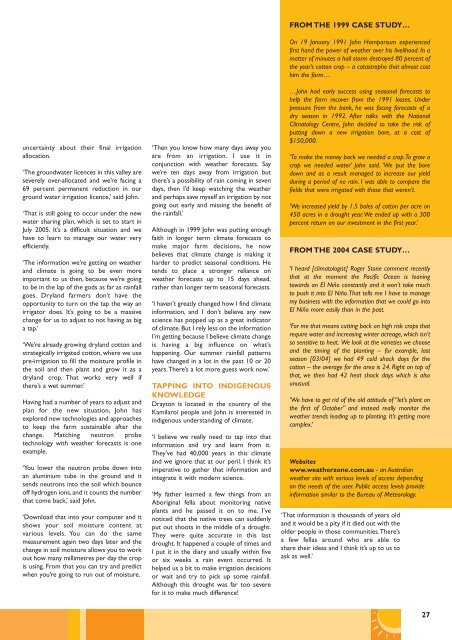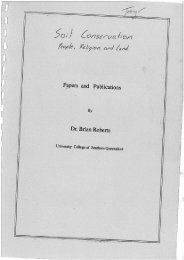Masters of the Climate: Innovative farmers ... - South West NRM
Masters of the Climate: Innovative farmers ... - South West NRM
Masters of the Climate: Innovative farmers ... - South West NRM
Create successful ePaper yourself
Turn your PDF publications into a flip-book with our unique Google optimized e-Paper software.
uncertainty about <strong>the</strong>ir final irrigation<br />
allocation.<br />
‘The groundwater licences in this valley are<br />
severely over-allocated and we’re facing a<br />
69 percent permanent reduction in our<br />
ground water irrigation licence,’ said John.<br />
‘That is still going to occur under <strong>the</strong> new<br />
water sharing plan, which is set to start in<br />
July 2005. It’s a difficult situation and we<br />
have to learn to manage our water very<br />
efficiently.<br />
‘The information we’re getting on wea<strong>the</strong>r<br />
and climate is going to be even more<br />
important to us <strong>the</strong>n, because we’re going<br />
to be in <strong>the</strong> lap <strong>of</strong> <strong>the</strong> gods as far as rainfall<br />
goes. Dryland <strong>farmers</strong> don’t have <strong>the</strong><br />
opportunity to turn on <strong>the</strong> tap <strong>the</strong> way an<br />
irrigator does. It’s going to be a massive<br />
change for us to adjust to not having as big<br />
a tap.’<br />
‘We’re already growing dryland cotton and<br />
strategically irrigated cotton, where we use<br />
pre-irrigation to fill <strong>the</strong> moisture pr<strong>of</strong>ile in<br />
<strong>the</strong> soil and <strong>the</strong>n plant and grow it as a<br />
dryland crop. That works very well if<br />
<strong>the</strong>re’s a wet summer.’<br />
Having had a number <strong>of</strong> years to adjust and<br />
plan for <strong>the</strong> new situation, John has<br />
explored new technologies and approaches<br />
to keep <strong>the</strong> farm sustainable after <strong>the</strong><br />
change. Matching neutron probe<br />
technology with wea<strong>the</strong>r forecasts is one<br />
example.<br />
‘You lower <strong>the</strong> neutron probe down into<br />
an aluminium tube in <strong>the</strong> ground and it<br />
sends neutrons into <strong>the</strong> soil which bounce<br />
<strong>of</strong>f hydrogen ions, and it counts <strong>the</strong> number<br />
that come back,’ said John.<br />
‘Download that into your computer and it<br />
shows your soil moisture content at<br />
various levels. You can do <strong>the</strong> same<br />
measurement again two days later and <strong>the</strong><br />
change in soil moisture allows you to work<br />
out how many millimetres per day <strong>the</strong> crop<br />
is using. From that you can try and predict<br />
when you’re going to run out <strong>of</strong> moisture.<br />
‘Then you know how many days away you<br />
are from an irrigation. I use it in<br />
conjunction with wea<strong>the</strong>r forecasts. Say<br />
we’re ten days away from irrigation but<br />
<strong>the</strong>re’s a possibility <strong>of</strong> rain coming in seven<br />
days, <strong>the</strong>n I’d keep watching <strong>the</strong> wea<strong>the</strong>r<br />
and perhaps save myself an irrigation by not<br />
going out early and missing <strong>the</strong> benefit <strong>of</strong><br />
<strong>the</strong> rainfall.’<br />
Although in 1999 John was putting enough<br />
faith in longer term climate forecasts to<br />
make major farm decisions, he now<br />
believes that climate change is making it<br />
harder to predict seasonal conditions. He<br />
tends to place a stronger reliance on<br />
wea<strong>the</strong>r forecasts up to 15 days ahead,<br />
ra<strong>the</strong>r than longer term seasonal forecasts.<br />
‘I haven’t greatly changed how I find climate<br />
information, and I don’t believe any new<br />
science has popped up as a great indicator<br />
<strong>of</strong> climate. But I rely less on <strong>the</strong> information<br />
I’m getting because I believe climate change<br />
is having a big influence on what’s<br />
happening. Our summer rainfall patterns<br />
have changed in a lot in <strong>the</strong> past 10 or 20<br />
years.There’s a lot more guess work now.’<br />
TAPPING INTO INDIGENOUS<br />
KNOWLEDGE<br />
Drayton is located in <strong>the</strong> country <strong>of</strong> <strong>the</strong><br />
Kamilaroi people and John is interested in<br />
indigenous understanding <strong>of</strong> climate.<br />
‘I believe we really need to tap into that<br />
information and try and learn from it.<br />
They’ve had 40,000 years in this climate<br />
and we ignore that at our peril. I think it’s<br />
imperative to ga<strong>the</strong>r that information and<br />
integrate it with modern science.<br />
‘My fa<strong>the</strong>r learned a few things from an<br />
Aboriginal fella about monitoring native<br />
plants and he passed it on to me. I’ve<br />
noticed that <strong>the</strong> native trees can suddenly<br />
put out shoots in <strong>the</strong> middle <strong>of</strong> a drought.<br />
They were quite accurate in this last<br />
drought. It happened a couple <strong>of</strong> times and<br />
I put it in <strong>the</strong> diary and usually within five<br />
or six weeks a rain event occurred. It<br />
helped us a bit to make irrigation decisions<br />
or wait and try to pick up some rainfall.<br />
Although this drought was far too severe<br />
for it to make much difference!<br />
FROM THE 1999 CASE STUDY…<br />
On 19 January 1991 John Hamparsum experienced<br />
first hand <strong>the</strong> power <strong>of</strong> wea<strong>the</strong>r over his livelihood. In a<br />
matter <strong>of</strong> minutes a hail storm destroyed 80 percent <strong>of</strong><br />
<strong>the</strong> year’s cotton crop – a catastrophe that almost cost<br />
him <strong>the</strong> farm…<br />
…John had early success using seasonal forecasts to<br />
help <strong>the</strong> farm recover from <strong>the</strong> 1991 losses. Under<br />
pressure from <strong>the</strong> bank, he was facing forecasts <strong>of</strong> a<br />
dry season in 1992. After talks with <strong>the</strong> National<br />
Climatology Centre, John decided to take <strong>the</strong> risk <strong>of</strong><br />
putting down a new irrigation bore, at a cost <strong>of</strong><br />
$150,000.<br />
‘To make <strong>the</strong> money back we needed a crop.To grow a<br />
crop we needed water’ John said. ‘We put <strong>the</strong> bore<br />
down and as a result managed to increase our yield<br />
during a period <strong>of</strong> no rain. I was able to compare <strong>the</strong><br />
fields that were irrigated with those that weren’t.<br />
‘We increased yield by 1.5 bales <strong>of</strong> cotton per acre on<br />
450 acres in a drought year.We ended up with a 300<br />
percent return on our investment in <strong>the</strong> first year.’<br />
FROM THE 2004 CASE STUDY…<br />
‘I heard [climatologist] Roger Stone comment recently<br />
that at <strong>the</strong> moment <strong>the</strong> Pacific Ocean is leaning<br />
towards an El Niño constantly and it won’t take much<br />
to push it into El Niño.That tells me I have to manage<br />
my business with <strong>the</strong> information that we could go into<br />
El Niño more easily than in <strong>the</strong> past.<br />
‘For me that means cutting back on high risk crops that<br />
require water and increasing winter acreage, which isn’t<br />
so sensitive to heat. We look at <strong>the</strong> varieties we choose<br />
and <strong>the</strong> timing <strong>of</strong> <strong>the</strong> planting – for example, last<br />
season [03/04] we had 49 cold shock days for <strong>the</strong><br />
cotton – <strong>the</strong> average for <strong>the</strong> area is 24. Right on top <strong>of</strong><br />
that, we <strong>the</strong>n had 42 heat shock days which is also<br />
unusual.<br />
‘We have to get rid <strong>of</strong> <strong>the</strong> old attitude <strong>of</strong> “let’s plant on<br />
<strong>the</strong> first <strong>of</strong> October” and instead really monitor <strong>the</strong><br />
wea<strong>the</strong>r trends leading up to planting. It’s getting more<br />
complex.’<br />
Websites<br />
www.wea<strong>the</strong>rzone.com.au - an Australian<br />
wea<strong>the</strong>r site with various levels <strong>of</strong> access depending<br />
on <strong>the</strong> needs <strong>of</strong> <strong>the</strong> user. Public access levels provide<br />
information similar to <strong>the</strong> Bureau <strong>of</strong> Meteorology.<br />
‘That information is thousands <strong>of</strong> years old<br />
and it would be a pity if it died out with <strong>the</strong><br />
older people in those communities.There’s<br />
a few fellas around who are able to<br />
share <strong>the</strong>ir ideas and I think it’s up to us to<br />
ask as well.’<br />
27
















